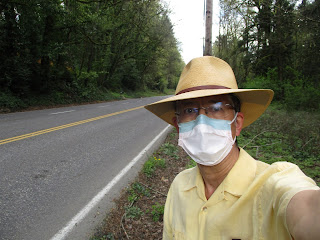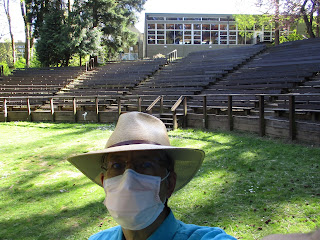I’ve noted some online confusion about the utility and import of wearing a face mask during this parlous era.
Carole and I have worn one every time we’ve gone out for the past three weeks, at least. (Once or twice, when I’ve taken the dog out for her final walk ’round midnight, I’ve forgotten my mine, but we rarely encounter anyone on the streets then; the selfie at left was taken along SW Taylors Ferry Road on April 6.)
During the day, my wife and I have observed maybe only half the pedestrians (and almost none of the cyclists) in our neighborhood wearing a mask. The ratio has been even lower in other parts of the city where I’ve walked.
In general, older people wear them, and younger ones do not. If anything, it would be preferable if the opposite were the case.
Whether simple face masks and home-made cloth ones make a significant difference in checking the spread of covid-19 is something of an open question; we know too little about transmission and symptoms, and we aren’t testing enough of the population to learn more quickly.
However, there are three basic reasons to wear a mask. They are:
1. TO PROTECT THE WEARER
1. TO PROTECT THE WEARER
Let’s get this out of the way: If you don’t have an N95 respirator, and you’re not a medical professional, a mask isn’t going to provide very good protection against infection.
They don’t fit well, for one thing. Also, most of us don’t use them correctly: Too often, we touch our mask repeatedly to adjust it, which in theory, contaminates our hands (or the mask from our hands) . . . and we probably don’t wash or disinfect it after every use, let alone dispose of it and employ a new one for every outing (probably because we don’t have enough on hand to do so). Here is my selfie at Rose City Book Pub, which I visited on April 8 to wish owner Elise Schumock a happy birthday.
But I’ve seen public comments that suggest certain people believe this is the ONLY reason to wear a mask . . . and since it’s not a very good or effective one, why bother?
Here’s why. . . .
2. TO PROTECT OTHERS
Here’s why. . . .
2. TO PROTECT OTHERS
A mask reduces the distance your breath travels, especially if you should cough. Instead of spreading clouds of everything that was in your lungs for two, three, or four feet in a cloud ahead of and around you (a sneeze can drive air up to eight feet away, or more!), you mostly just leave a vapor trail behind you as your breath leaks out the sides of your mask.
Most of the vapor droplets evaporate fairly quickly, which means you’re less likely to infect others. Citizens of Asian nations such as Japan, Taiwan, and South Korea are accustomed to responding voluntarily to calls for self-isolation and masking during medical emergencies, and the rates of death from novel coronavirus around the world would suggest their behavior has been effective.
Here’s a graph of mortality by global region that is being steadily updated on the “Our World in Data” website. Compare Asia to the rest of the world as of today:
Here’s a graph of mortality by global region that is being steadily updated on the “Our World in Data” website. Compare Asia to the rest of the world as of today:
The primary explanations for the fact that Japan, Taiwan, and South Korea have much lower rates of infection than the U.S. — and far lower rates of mortality (deaths per total cases of coronavirus) — are that they’ve observed self-isolation and masking much more broadly . . . and/or they’ve tested a much greater percentage of their population.
(Below, a selfie in the open-air amphitheater on the deserted campus of Reed College; I acted in several productions of ancient Greek plays between 2005 and 2009, and revisited the site on April 14.)
But I’m not sick, you protest. I haven’t had any cough or fever or chills or loss of taste or any of the other symptoms I’ve read about.
Please remember, though, that we still know very little about the behavior of the novel coronavirus. We do know that:
A) Symptoms do not necessarily show up until anywhere from 2 to 14 days after exposure to the virus — thus, there’s a chance you could be recently infected and passing the virus on to others
A) Symptoms do not necessarily show up until anywhere from 2 to 14 days after exposure to the virus — thus, there’s a chance you could be recently infected and passing the virus on to others
and
B) An unknown number of people never show any symptoms
Data collected by the World Health Organization in China suggested about 25 percent of the people who were in close contact with covid-19 patients never experienced any symptoms. A study in Nanjing, China followed 24 people who tested positive for the virus and from one to three weeks later, seven of them showed no symptoms at all. (They tended to be young; the median age was 14.)
Researchers at a lab in Iceland reported in early April that 50 percent of the people who tested positive for coronavirus there were asymptomatic. Whether this makes them more or less likely to infect others is probably unknown. But the terms “silent spreaders” and “super spreaders” have surfaced in reference to people who — again, in theory — could be infecting others without knowing it.
(Left: Leland I metal sculpture by Lee Kelly and Bonnie Bronson, circa 1975, in the American Towers Plaza near SW First and Lincoln, where I walked on April 20.)
(Left: Leland I metal sculpture by Lee Kelly and Bonnie Bronson, circa 1975, in the American Towers Plaza near SW First and Lincoln, where I walked on April 20.)
The Israeli Health Ministry estimated that, among children under the age of 9, about 27 percent were showing no symptoms, which made them the champion “silent spreaders” — compared to a rate of 7 percent asymptomatic folks in the 20-to-29 age group, and between 4 and 7 percent among cohorts above the age of 50.
The sad part, of course, is that mortality rates in the older age ranges appear to be much higher. Compare the differences within various age demographics in Italy, as of this week:
So why not choose to be a “good guy with a mask”? Assume you might be a carrier and collapse the respiratory cloud you generate in public.
There is, however, one other good reason to wear a mask. . . .
3. TO SIGNAL SOCIAL CAUTION AND COOPERATION
At this point, a mask in public also serves as a badge and a sign. You’re signaling caution to others. The message is: I’m concerned about the pandemic, and I will make an effort to avoid coming too close to you. I hope you will accord me the same consideration. (Below, Urban Center at Portland State University, SW 5th and Montgomery, April 23.)
It’s also a constant reminder to yourself to exercise caution — both in approaching others and to avoid touching your nose and eyes. In a sense, the mask serves a similar purpose to that of rosaries or a prayer shawl: it both signals and compels heightened attention, because the activity demands it. Like the tools of prayer (or the repetition of a mantra), the mask is a message to yourself and anyone who might see you to BE HERE, NOW.
Your mask also serves as a badge of solidarity with the hundreds of thousands of people around the world who are suffering from covid-19, and the medical teams laboring to save them (if they’re lucky enough to be sick within reach of health facilities — probably not the case in India, the ’stans, and huge swatches of Africa).
I don’t want others to die, you declare to everyone when you wear a mask in public, and I am both reducing the chances I will contribute to that result and supporting the folks who are striving to save the lives of others.
So . . . protecting yourself? Not so much.
Protecting others? Very possibly.
Protecting others? Very possibly.
Making a public declaration that we’re all in this together? Definitely.
See “A Journal of the Plague Year, Week 4”
See “A Journal of the Plague Year, Week 3”
See “A Journal of the Plague Year, Week 2”
See “A Journal of the Plague Year, Week 1”
See “Covid-19 Stat Watching, Considered as a Fairgrounds Horse Race”
* * * * *
See “A Journal of the Plague Year, Week 4”
See “A Journal of the Plague Year, Week 3”
See “A Journal of the Plague Year, Week 2”
See “A Journal of the Plague Year, Week 1”
See “Covid-19 Stat Watching, Considered as a Fairgrounds Horse Race”












No comments:
Post a Comment